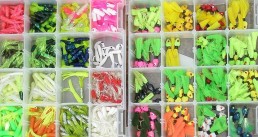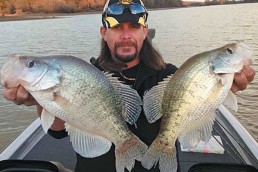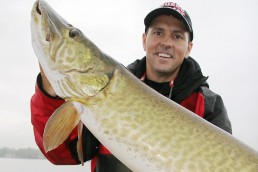Hook up with Slabs using Crappie Tactics
SHARE THIS POST
Southern and middle states are enjoying catching crappies right now. Techniques vary from lake to lake, but typical baits can work in each one. Temperature, water color, structure and fish size all play a factor in what does and doesn’t work.
Double-hook jig rig
Fish are often sluggish and slow when water is very cold. A jig tipped with a minnow produces crappies from late winter through spring. A popular tactic is to slow-troll double-jig rigs with the jigs tipped with minnows.
Double-hook rigs of any style serve two important things: First, two baits offer two different depths to help hit the right strike zone, and the rig offers two baits, different colors and different options.
A double-jig rig can be tied with jigs 12 to 30 inches apart. The deeper the fish, the farther apart baits should be tied. The top jig can be tied on a small loop, about 2 inches long. The 1/8-ounce jigs are a good choice in mid-depths or at 1/16 ounce in shallower water. It’s important to keep baits down and vertical.
Simple jig
Fishing guide Brad Whitehead says his southern style of fishing and bait p
resentations work in the South, North and everywhere in between. He prefers to keep his baits as simple as possible because it’s more fun and it’s easier for his clients to use.
“When vertical jigging, I like having one jig, a good plastic tube on a TeeZur jig head,” says Whitehead. “It’s easy to present the bait slowly, have full control of it and be able to even feel the light bites. My pole is a sensitive 10- or 11-foot B‘n’M Pole.”
Double-jig pulling
Whitehead also uses his primary technique as the water warms.
“I side-pull baits, like trolling, except the boat is sideways,” he says. “A totally different bait strategy works better for this technique. Pulling two hair jigs get more strikes than any other bait we’ve found. The bright hair in orange, pink, chartreuse or other color, draws the attention of the fish and they hit it out of reflex. It’s a deadly tactic with the bait rig making a huge difference in the number of fish we catch.”
Kentucky Lake in early spring
Kentucky Lake guide Richard Williams says fishing from late winter into the spring is good. He says many fish are pulled off the ledges now.
Are you enjoying this post?
You can be among the first to get the latest info on where to go, what to use and how to use it!
“I use a jig I hand-pour usually in a 3/32 ounce weight,” Williams says. “I’ll leave some heads unpainted, but orange and chartreuse colors are both top producers here on Kentucky (Lake). I’ll use a Southern Pro tube and tip with Berkley Trout Nibbles. I usually don’t tip with a minnow because bites can be light, so if I feel something I want to know it’s a fish. I often hold a B‘n’M Crappie Wizard 10-foot pole in each hand.”
Head-minnow combo
Williams has another bait in mind when he uses a minnow.
“This is different than the previous rigging, because minnows are the key bait. The minnow poles can be put in holders because fish hang onto a minnow longer than they will a straight jig. I like a slip-head jig, but leave the plastic body off. This gives a balanced jig and one where the hook is fully exposed when a crappie bites. My favorite head colors include purple and orange.”
Matched baits
I’m sure when a northern fisherman reads about a 1/4-ounce jig with a 3 1/2-inch minnow tipping that it seems like a radical, non-practical bait for a crappie. However, it’s the perfect fit for Grenada Lake crappies in the spring.
Take the same monster bait up North and a fisherman would be lucky to catch one crappie on it. The moral is easy: Match the bait to the season, lake and size fish you are targeting. A lake with small baitfish needs baits that are small. Testing different sizes in baits is also important to see which the crappies prefer.
Large minnow
There are times when a big minnow by itself, or tipped on a jig head, can be a big advantage. High, nasty water is not a fun time to fish, but a fisherman can improve his or her odds. A single minnow that is larger than normal gives two major advantages: It looks natural and gives off a lot of flash and puts off more sound waves than a small minnow. Crappies can find a big minnow easier than a small minnow.
The basic jig box
Since changing baits can produce different results, here are a few guidelines for that theory. First, it’s best to have a “confidence” jig and stick with it as much as possible. When fish don’t bite, change colors. Nothing is set in stone, but here are a few guidelines for choosing colors.
For clear water use clear-sparkle, shad, smoke, pink-white and shad-lemon. Stained water can be blue-white, orange-chartreuse, blue-chartreuse and pumpkinseed. For heavy stain/muddy water try orange-chartreuse, lime-chartreuse glow and black-chartreuse.
Very small jigs have a place and time
Southerners have learned from their northern fishing friends—sometimes fish just want a small offering. Whether it’s due to the available food source or the mood of the fish, small offerings may quickly change a no-bite day into an active one. The 2014 Classic was won on Mississippi water using very small jigs.
It’s too bad there is no one, secret bait that guarantees success. However, part of the fun is working through the crappie-catching puzzle that includes picking the right bait.
MWO
SHARE THIS POST
Did you enjoy this post?
You can be among the first to get the latest info on where to go, what to use and how to use it!
Tim Huffman
Tim Huffman specializes in crappie fishing, is editor for two crappie magazines, as well as writing for several others. In 2018, he published his sixth book, Limiting Out for Crappie, available at Amazon. His first article appeared in MidWest Outdoors in 1988.



